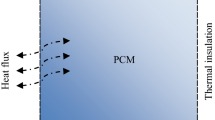Abstract
Based on theoretical analysis of PCM (Phase Change Material) solidification process, the model of improved void cavity distribution tending to high temperature region is established. Numerical results are compared with NASA (National Aeronautics and Space Administration) results. Analysis results show that the outer wall temperature, the melting ratio of PCM and the temperature gradient of PCM canister, have great difference in different void cavity distribution. The form of void distribution has a great effect on the process of phase change. Based on simulation results under the model of improved void cavity distribution, phase change heat transfer process in thermal storage container is analyzed. The main goal of the improved designing for PCM canister is to take measures in reducing the concentration distribution of void cavity by adding some foam metal into phase change material.
Similar content being viewed by others
References
Zhang L., Yu Z.T., Fan L.W., Wang W.J. (2013). An Experimental Investigation of the Heat Losses of a U-Type Solar Heat Pipe Receiver of a Parabolic Trough Collector- Based Natural Circulation Steam Generation System. Renewable Energy, 57(3), 262–268
Thayer J., Rosenfeld J., Galbraith R. (2013). Thermal Energy Storage for a Dish Stirling Concentrated Solar Power System. 11th International Energy Conversion Engineering Conference, San Jose, California
Xiao L. (2012). Convection Heat Loss Characteristics of the Heat Pipe Receiver in Solar Dish/AMTEC Thermal Power System, Ph.D. thesis, Chongqing University, China
Roger A. (1991). Evaluation of Thermal Energy Storage Devices for Advanced Solar Dynamic Systems. Journal of Solar Energy Engineering, 113(4), 138–145
Dong K.Y., Yuan X.G. (1998). Two-Dimensional Transient Heat Transfer Analysis of a Phase Change Material Container. Taiyangneng Xuebao, 19(1), 41–47
FLUENT Inc (2003). FLUENT 6.2 User's Guide Manual. Lebanon New Hampshire
Voller V. R., Swaminathan C. R. (1991). Generalized Source-Based Method for Solidification Phase Change. Numerical Heat Transfer Fundamentals, 19(2), 175–189
Dong K.Y. (1998). Thermal Analysis of High Temperature Solid-Liquid Phase Change Thermal Energy Storage Container. Ph.D. thesis, Beijing University of Aviation and Aerospace, Beijing, China
Zhao Y. X. (2003). Tutorial of FLUENT. The Press for National Defense University of Science and Technology, Changsha, China
Strumpf H.J., Coombs M.G. (1988). Advanced Heat Receiver Conceptual Design Study. NASA-88-25977, Lewis Research Center, Ohio, USA.
Acknowledgement
The authors acknowledge the financial support provided by National Natural Science Foundation of China (Grant No.51476172).
Author information
Authors and Affiliations
Additional information
This research is financially supported by National Natural Science Foundation of China (Grant No.51476172).
Rights and permissions
About this article
Cite this article
Gui, X., Song, X. & Nie, B. Thermal analysis of void cavity for heat pipe receiver under microgravity. J. Therm. Sci. 26, 138–143 (2017). https://doi.org/10.1007/s11630-017-0922-y
Received:
Published:
Issue Date:
DOI: https://doi.org/10.1007/s11630-017-0922-y




